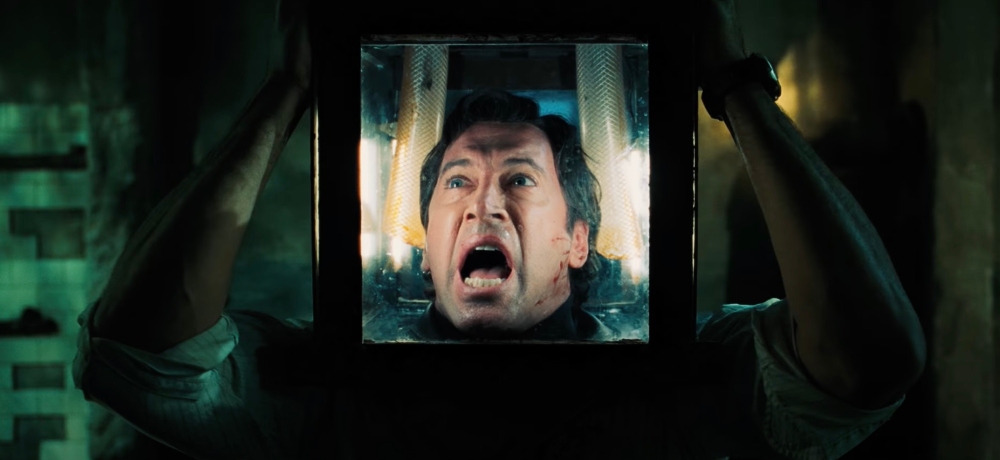


No good villain is ever truly gone, especially in horror movies. This September saw the return of Tobin Bell as John Kramer, a.k.a. “Jigsaw,” the trap-making serial killer of the Saw movies, with the release of Saw X. This is despite the fact that Kramer has been dead since the end of Saw III, which came out back in 2006. But a little thing like death never stopped the Saw franchise. Instead of literally bringing Kramer back from the dead, the subsequent sequels continued Bell’s participation with devices like flashbacks. Hell, even Saw IV played a trick on audiences by staging a lot of its action at the same time as Saw III.
One of those post-Kramer sequels celebrates its 15th anniversary this year: Saw V, which featured Costas Mandylor as Detective Mark Hoffman, a murderous cop who became Jigsaw’s protégé and continued his campaign of bloodshed. However, the David Hackl-directed entry has never been considered a high point of the franchise. In fact, when it came out, I remember some thinking the series had hit a new low. But does 15 years make a difference?
Saw V found Hoffman setting himself up as a hero after the bloody events of Saw III and IV, but not expecting FBI agent Peter Strahm (Scott Patterson) to have survived them. Making things more problematic for Hoffman is that Strahm suspects him as being involved with Kramer and goes rogue against his boss’ orders to investigate him. But as Hoffman deals with Strahm, he also continues Kramer’s work with five people (including Julie Benz and Meagan Good) he has abducted who are connected. Hoffman puts them through a series of bloody tests that will either result in them emerging triumphant—or coming out in pieces.
Fifteen years down the road from Saw V’s initial release, the film does play better than it did in 2008. Although it’s not the series’ strongest effort, it is pretty entertaining and fun, even if this was the point in the Saw series where keeping track of all the plot threads started to feel a bit tiring. (It’s a problem that a lot of comic book movies have today.)
Saw V also comes off as a very cynical and pessimistic movie 15 years later. Although the series often specialized in giving us morally complicated characters, its fifth chapter barely gives any who are likable in the usual sense. This might be thanks to the involvement of screenwriters Patrick Melton and Marcus Dunstan, who penned multiple Saw films, as well as the creature feature Feast and its subsequent sequels. Those films featured despicable characters who battled monsters and were ready to sell each other out at a moment’s notice to survive. Feast II: Sloppy Seconds even featured an infamous scene where a character tries to save a baby—and then changes his mind and throws the young one to the monsters to get them off his trail. A lot of the characters in Saw V seem cut from the same cloth.
(Spoiler Warning Ahead!)
Although Strahm is trying to prove Hoffman is a murderer, Patterson’s performance makes it feel more like the investigator is driven by his own ego and personal pride than actual justice. Hoffman’s captors also frequently use each other as they move from trap to trap. This is against the direction that Hoffman—as Jigsaw—gives them to go against their selfish nature, leading to a scene where Benz and the only other sole survivor (Greg Bryk) realize that all five of them could have survived—if they had simply worked together. Saw V is truly a depiction of how teamwork could have made the dream work, but instead selfishness managed to turn a dire situation into a bigger nightmare. Benz and Bryk also discover that all of five of them were connected in a tenement fire that killed eight innocents due to their greed. After they call each other “monsters,” Bryk decides, “We both deserve to be here.” And it’s hard to disagree with him.
You also have to give credit to Hackl, Melton, and Dunston for delivering two of the most memorably gruesome sequences in the Saw franchise. One comes at the climax, when Benz and Bryk have to stick their hands into saws in a device that will collect 10 pints of blood, so they will survive. The other happens during Saw V’s ending. After Strahm searches for Hoffman underground, he finds a room with a coffin-like case and a tape recorder. When Strahm plays the tape, he hears a warning from Hoffman that advises him to get inside the case, which has shards of broken glass inside.
Understandably, Strahm ignores the warning and decides to lock Hoffman himself in the case. But after he does, the door to the room locks, and its walls begin moving in on Strahm, like a trash compactor. Hoffman—who can barely hide his smile—is safely lowered into the floor, while Strahm suffers a bone-crushing, blood-drenched death. When Saw V’s poster claimed, “You won’t believe how it ends,” it wasn’t kidding. It is a satisfyingly deranged ending in a series that specialized in such set pieces.
At the time, Saw V had the worst reviews of the series, but it was still a financial success. The next film, Saw VI, was a better movie but did not do as well box office-wise, most likely thanks to the release of Paranormal Activity.
But after two attempts to reboot the series, Saw X gives Bell another go-around as Jigsaw. This time, the sequel does it by setting its action in between Saw and Saw II, so that Jigsaw is alive and doing his mayhem himself. If you haven’t checked it out yet, you’ll just have to wait and see if it is one of the great ones or a serviceable but enjoyable entry like Saw V. But one thing is certain, as Jigsaw himself might say: there will be blood.